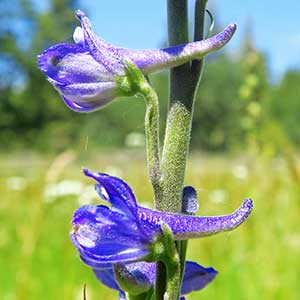Delphinium distichum
Delphinium antoninum
Burke's larkspur, meadow larkspur, strict larkspur, two-spike larkspur
Anthony Peak larkspur, Tracy's larkspur
(25-)30-60(-80) cm;
base sometimes reddish, puberulent.
(7-)15-30(-60) cm;
base reddish, glabrous to puberulent.
blade cuneate to semicircular, 1-5 × 1.5-7 cm, puberulent; ultimate lobes 5-19, width 2-8(-15) mm (basal), 0.5-3(-5) mm (cauline);
margins of basal leaf, measured less than 1 cm from blade base, demarcating considerably more than 90° of arc when leaf laid flat;
most cauline leaf blades exceeding internodes.
blade round, 0.8-4 × 1.2-8 cm, ± succulent, nearly glabrous; ultimate lobes 3-15, width 1-8 mm (basal), 1-4 mm (cauline).
8-30(-40)-flowered, usually dense;
pedicel 0.5-1.5 cm, puberulent;
bracteoles 0-3 mm from flowers, green to blue, linear, 4-8 mm, puberulent.
3-25-flowered;
pedicel (0.6-)1.2-3.2 cm, usually puberulent;
bracteoles 4-6 mm from flowers, green, linear, 3-5 mm, puberulent.
sepals dark blue to bluish purple, puberulent, lateral sepals ± erect, 8-12 × 3.5-5 mm, spurs straight, horizontal or nearly so, 9-15 mm;
lower petal blades ± covering stamens, 4.5-6.5 mm, clefts 2-3 mm;
hairs centered mostly near base of cleft, white.
sepals dark blue to white, nearly glabrous, lateral sepals spreading to reflexed, 11-13 × 4-6 mm, spurs straight to gently decurved, within 30° above or below horizontal, 12-16 mm;
lower petal blades elevated, exposing stamens, 3-7 mm, clefts 1.5-3 mm;
hairs centered, mostly on inner lobes above base of cleft, white.
7-13 mm, 3.5-4 times longer than wide, ± puberulent.
14-22 mm, 3.5-4 times longer than wide, puberulent.
seed coat cells with surfaces roughened.
unwinged;
seed coat cells with surfaces smooth.
= 16.
Delphinium distichum
Delphinium antoninum
Delphinium distichum hybridizes with D. multiplex and D. nuttallianum (D. ×diversicolor Rydberg). The name D. burkei has often been misapplied to D. distichum.
(Discussion copyrighted by Flora of North America; reprinted with permission.)
Of conservation concern.
Delphinium antoninum hybridizes with D. decorum subsp. tracyi and with D. nudicaule. Most often confused with D. decorum subsp. tracyi, it is separable on the basis of its longer root, usually reflexed sepals, and typically colorfast flowers. It also may be confused with D. andersonii; see discussion under that species.
(Discussion copyrighted by Flora of North America; reprinted with permission.)
- Local floras:
BC,
OR,
WA
- Local Web sites:
Flora NW,
PNW Herbaria
WildflowerSearch
iNaturalist (observations)
USDA Plants Database
- LBJ Wildflower Center
- SEINet
- Plants of the World Online
- Encyclopedia of Life
- Wikipedia
- Google Image Search


